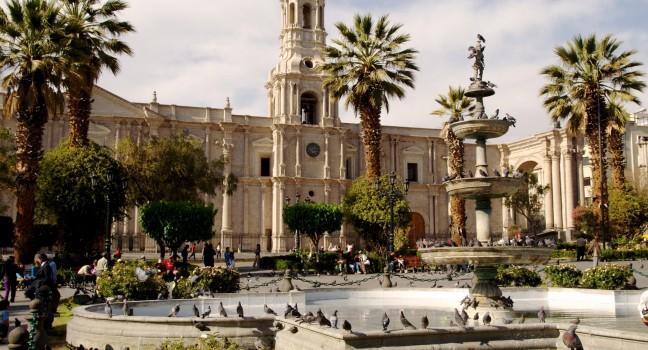Arequipa

Cradled by three steep, gargantuan, snow-covered volcanoes, the jaw-dropping, white-stoned Arequipa, one of the most visually stunning cities in Peru, shines under the striking sun at 2,350 meters (7,710 feet). This settlement of nearly 1 million residents grew from a collection of Spanish-colonial churches and homes constructed from white sillar (volcanic stone) gathered from the surrounding terrain. The result is nothing less than a work of art—short, gleaming-white buildings contrast with the charcoal-color mountain backdrop of El Misti, a perfectly shaped cone volcano.
The town was a gathering of Aymara Indians and Incas when Garí Manuel de Carbajal and nearly 100 more Spaniards founded the city on August 15, 1540. After the Spanish arrived, the town grew into the region's most profitable center for farming and cattle raising—businesses still important to Arequipa's economy. The settlement was also on the silver route linking the coast to the Bolivian mines. By the 1800s, Arequipa had more Spanish settlers than any town in the south.
Arequipeños call their home La Ciudad Blanca, "The White City," and the "Independent Republic of Arequipa"—they have made several attempts to secede from Peru and even designed the city's own passport and flag. Today, the town is abuzz with adventure outfitters leading tours into the surrounding canyons, locals and visitors mingling at bars and cafés in 500-year-old sillar buildings, and shoppers seeking the finest alpaca threads anywhere in the country. On August 15, parades, fireworks, bullfights, and dancing celebrate the city's founding.
Arequipa enjoys fresh, crisp air, and warm days averaging 23°C (73°F) and comfortable nights at 14°C (57°F). To make up for the lack of rain, the Río Chili waters the surrounding foothills, which were once farmed by the Inca and now stretch into rows of alfalfa and onions.
Recommended Fodor's Video
Elsewhere in Arequipa
Chivay >
Restaurants (4), Things to do (6), Hotels (7)
Chucuito >
Restaurants (0), Things to do (0), Hotels (1)
Camana >
Restaurants (0), Things to do (0), Hotels (0)
Chala >
Restaurants (0), Things to do (0), Hotels (0)




